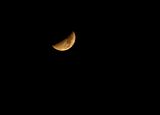This will probably be my last tutorial before I move to Denmark. This will take some time to master and since clear skies are rare I reckon it will take some pictures before you have a decent photo of the moon. If you don't own a D-SLR, a telescope and a fitting adaptor this is what you'll need:
- A compact camera, preferably with manual focus.
- A pair of binoculars or a telescope.
- Tripod.
- Flashlight.
- Optional: carton, tape, glue, rubber etc (in order to build your own adaptor ring; building instructions not included in this tutorial)
- Patience.
- Luck.
If you have all the above we are ready to roll. Put your camera on a tripod. If you use a telescope (which usually has its own tripod) try making an adapter ring that will hold the camera in place. Pair your camera with the binoculars/telescope. Use the built in zoom of your camera to get rid of vignette effects in the corners. If you are using binoculars the easiest way to focus is to use the cameras manual focusing to get the picture sharp. On a telescope you should be able to manually focus using a dial. Take a few test shots in daylight. Pray for clear skies and wait.
When there are clear skies and the moon is up (preferably at a low angle so you won't hurt your back) you are almost ready to take a picture of it. But before you direct your binoculars/telescope at the moon you have to do some more tweaking with your camera. If you have a full manual mode (noted M) you can manually set your exposure. For a full moon I can recommend a setting around 1/600 but for a half moon or less you are alright with 1/250. Remember that the exposure time may vary depending on the optics of the binoculars/telescope (since they let through different amounts of light; 7x50 lets through more light than 7x35 etc) and also how much sunlight is reflected from the moons surface (see below). If your camera hasn't got image stabilization of some sort you better use a timer so pressing the shutter won't spoil the picture. With some luck you just took a brilliant photo of the moon. It is more likely that your focus was a little off or that the camera or binoculars/telescope wasn't perfectly still during the exposure. Try again and again until you are satisfied or tired.

If you don't have full manual control of your camera (which is a more likely scenario considering we are using compacts) we'll have to fool the camera into shortening its exposure time. This is easily done with a flashlight. With your camera manually focused to get a clear picture of the moon remove it from the binoculars/telescope. Direct your camera at the flashlight and half press down the shutter to get an exposure reading of around 1/600 for a full moon or around 1/250 for a half moon. With the shutter still pressed half down, pair the camera with the binoculars/telescope, direct your setup at the moon and press down the shutter. Tada. Chances are it didn't work or that you let go of the shutter button and that's why you need patience and loads of luck.
In order to encourage you not to give up you could visit my photo page on Picasa or click the images below to enlarge. If you look in the description you see that the exposure of the white blob was 1/61" and the exposure of the full moon was 1/60". This is because the blob was photographed when the moon was at a higher angle, which means more sunlight was reflected from the moon which in turn means more light into the camera and shorter exposures are needed to get a good detailed picture.
Come to think of it this was more of a project than a tutorial. You really have to experiment your way to good results. So have fun experimenting!



No comments:
Post a Comment